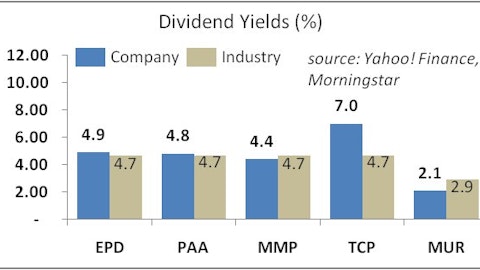According to the CIA World Fact Book, the United States operates the largest single-country economy in the world. Its gross domestic product for 2011 was estimated at $15.3 trillion, trailing the European Union, which is comprised of 27 different countries, by only $360 billion. China remains in third place, as the developing economy continues to see rapid growth in recent years due to its build out of industrial capacity and its growing class of individual consumers. Growth in the U.S., however, remains subdued below 2%. The global economic slowdown has certainly hampered the nation’s growth, but there still remains a few economic bright spots, namely the advancement of domestic energy production [for more commodity news and analysis subscribe to our free newsletter].
| Rank | Country | GDP (Purchasing Power Parity) |
|---|---|---|
| 1 | European Union | $15,650,000,000,000 |
| 2 | United States | $15,290,000,000,000 |
| 3 | China | $11,440,000,000,000 |
| 4 | India | $4,515,000,000,000 |
| 5 | Japan | $4,497,000,000,000 |
| 6 | Germany | $3,139,000,000,000 |
| 7 | Russia | $2,414,000,000,000 |
| 8 | Brazil | $2,324,000,000,000 |
| 9 | United Kingdom | $2,290,000,000,000 |
| 10 | France | $2,246,000,000,000 |
The U.S., along with other mega-economies, demands massive amounts of commodities. And while some countries depend solely on the inflow or outflow of goods, the U.S. dominates in both of its roles as importer and exporter. Last year, the United States exported an estimated $1.5 trillion outside of its borders, making it the third largest exporter in the world. Our northern and southern neighbors received the majority of these exports, with Canada and Mexico consuming 19% and 13.3% of total exports, respectively. Outflows to China represented 7% of exports, as the U.S. continues to help supply the country’s growing demand of commodities.

Top U.S. Exports & The Growing Energy Sector
Capital goods, such as aircraft, automotive parts, computers and telecom equipment, are the largest portion of the U.S.’s outflows, accounting for nearly 49% of total exports. Industrial supplies, particularly organic chemicals, represent the second largest commodity class at 26.8%. Agricultural products also make up a significant portion of exports, with soybeans, fruit, and corn representing the top three agricultural exports [see also Agribusiness ETFs Head-To-Head: CROP vs. MOO].
| Top Exports | Percent of Exports |
| Capital Goods | 49.0% |
| Industrial Supplies | 26.8% |
| Consumer Goods | 15.0% |
| Agriculture | 9.2% |
While the above top exports do represent the lion’s share of U.S.’s outflows, it is important to note the nation is once again becoming a top exporter of energy-based commodities. Natural gas production has risen significantly in recent years, ranking the U.S. third in the world for total natural gas production. However, Americans consumed 689.9 billion cubic meters of NG in 2011, more than it had produced. While the country continues to try to satisfy its insatiable need for natural gas, it still manged to export 42.7 billion cu m last year, the second largest worldwide. But thanks to the growing popularity of hydraulic fracturing, or fracking technologies, this total is projected to continue to increase significantly.
Crude oil, however, is a much different story. The U.S. remains the number one consumer and importer of crude. The country does, however, produce close to as many barrels of oil per day as it consumes. While exports amount to less than 50,000 barrels per day, fracking techniques have helped total production increase somewhat rapidly in recent years [see also Can Oil Fix U.S. Unemployment?].
How to Play U.S. Commodities
One of the most compelling plays in U.S. commodities today is on the ample and growing supply of natural gas. The rapid growth in supply combined with tepid near-term economic trends have resulted in a supply glut and depressed prices. However, this is not expected to persist over the longer haul. Therefore, investing in domestic producers, like Chesapeake Energy Corporation (NYSE:CHK) and Devon Energy Corporation (NYSE:DVN), could pay off within a few years [see also 5 Natural Gas Stock Picks].
Developments have also been made for the exporting of natural gas. The largest integrated energy players, including Exxon Mobil Corporation (NYSE:XOM) and Chevron Corporation (NYSE:CVX) offer somewhat safer upside potential to exporting the commodity, though their performances are also dependent on global energy production and demand.
For those looking to use the ETF wrapper to gain exposure to different industries in the U.S. energy sector, there are several options. iShares offers a number of compelling ETFs, such as the iShares Dow Jones US Energy Sector (NYSEARCA:IYE), which offers top exposure to Exxon, Chevron and other integrated energy leaders. The iShares Dow Jones US Oil & Gas Exp. (NYSEARCA:IEO) offers purer exposure to the benefits of fracking, as it tracks domestic oil and gas producers and explorers. Top holdings include Devon Energy Corporation (NYSE:DVN), Occidental Petroleum Corporation (NYSE:OXY), Anadarko Petroleum Corporation (NYSE:APC), Apache Corporation (NYSE:APA) and EOG Resources, Inc. (NYSE:EOG) [see also Top 5 Global Oil Stocks by Market Cap].
Bottom Line
Few commodity investors would have predicted that the United States would return to its heyday of energy production. However, innovative technologies and developments, such as fracking, have pushed the country back to the forefront of natural gas production. The size and robustness of the U.S. economy means that it will remain a significant importer and exporter of basic commodities, including food, energy, and precious metals. It will also be able to capitalize on acceleration in demand for commodities from Asia as their populations continue to surge.
This article was originally written by Ryan Fuhrmann, and posted on CommodityHQ.





